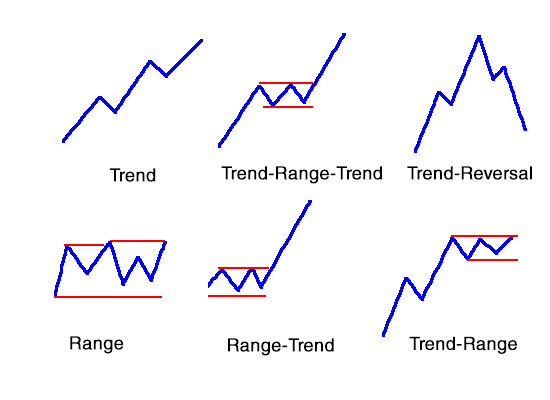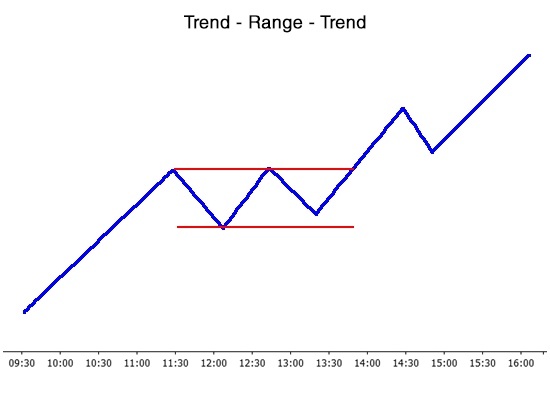A roadmap for the trading day
When I was an active intraday trader, one of the things that was most important to me was having a rough roadmap for the day: what is most likely to happen, based on the current market structure and most likely emerging volatility conditions. This is the same concept that I've been exploring in these daily S&P charts that I have been sharing here, and also publish in my daily research reports.
Be clear, it's not that we are trying to predict the future with these. We are saying that "this is most likely to happen", but it's important to go into the trading day with a full awareness that, quite literally, anything can happen. A certain percentage of the time, the less likely, or, in some cases, the exceedingly unlikely, will happen--and that is valuable information. Have a plan, but be flexible--maybe that's the best way to think of it. Always work to respond to the developing message of the market.
Having said that, most trading days fall into a handful of patterns. Usually, we can think of the day in three large divisions: the open and morning, which is usually characterized by volatility, volume, and tends to see price movement. Lunchtime is a period when the market often takes a break as well; volume and trading interest usually dry up. Lunch often starts sometime around noon (EDT), but can start earlier, depending on the trading day. In the afternoon, the market often sees a renewed burst of activity, often sometime in the 13:30 - 14:30 time area. (Of course, finer divisions are possible, as the last 10 minutes or first 5, for instance, have some specific tendencies. We are dealing with big picture here, though.)
So, with these three broad divisions of the day, and knowing the market can basically either trend or range, we come up with a few common trading patterns that describe action in the trading day. This applies to stock indexes, but also to individual stocks. (Currencies and other commodities require some adjustment to session times.) Here's a graphic that shows the six common day patterns, and a little more detail on each. (Note that I'm only considering uptrends here as the direction of trend doesn't matter. Downtrends are, obviously, just about as likely as uptrends, so the important point is the separation between trending and ranging activity, not the direction of trend.)

- Trend day: These can be dramatic, strong trends, or they can be quiet, with insistent pressure against either the high or low. In all cases, they tend to see relatively little retracement or movement against the trend. Many traders can make their month in a single trading day. On the other hand, if you're a fade trader, fading a strong trend day can easily wipe out a few months' profits! A major part of our homework and analysis is on identifying the likelihood of a strong trend day developing.

- Range Day: Multiple tests of both the highs and lows, but without any clear direction overall. There may be good trends within this day, the range may be tight or narrow, but the distinguishing factor is multiple attempts and failed breakouts at the highs and lows. Range days tend to be common in most products and environments.

- Trend and reversal: Though not extremely likely, strong intraday trends do sometimes reverse into an equally strong (or stronger) reverse trend. Do not assume that an early morning trend will just chug along into the close--if you fade a reversal, it's possible to give back far more than what you made in the morning. For most traders, these types of days represent a significant risk. Furthermore, they are pretty rare, which makes the psychology of these days even more difficult.

- Trend-range-trend: In many ways, this is the classic trend day pattern, in which the market takes a pause in the midday before breaking into another afternoon trend leg. The message here is to often be careful fading afternoon breakouts (in the critical time window) following a strong early morning trend. Yes, some of these do break down, but it's possible to identify days in which we have an edge for this type of continuation to develop.

- Trend that fails into a range: Ah, but not so fast. Don't count on that afternoon trend, because there are days in which a strong early morning trend terminates into a range that goes nowhere! Good news, though--this type of day often sets up some good plays for the following trading day.

- Morning range, then trend day: Typically, the market pauses around lunchtime, but it's possible to see a tight early morning range that breaks into a trend. If the morning is tight, the trend breakout may come earlier than we'd usually expect. This type of setup can often follow a few days' consolidation, so the trend breakout can catch traders off guard. It's always worth keeping this possibility in mind when the morning is dull.

These are simplified roadmaps, broad ideas, big picture context for the intraday trader. Applying them, and understanding what the most likely outcome for the current day is, requires a certain degree of skill and experience. I'll talk about how to get that experience in an upcoming blog post.



